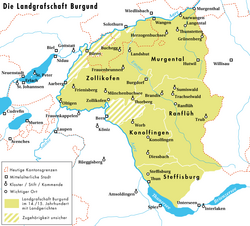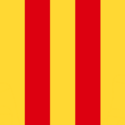Draft:Landgraviate of Burgundy
You can help expand this article with text translated from the corresponding article in German. (January 2025) Click [show] for important translation instructions.
|
| Submission declined on 10 January 2025 by DoubleGrazing (talk). Thank you for your submission, but the subject of this article already exists in Wikipedia. You can find it and improve it at Landgraviate of Burgundy instead.
Where to get help
How to improve a draft
You can also browse Wikipedia:Featured articles and Wikipedia:Good articles to find examples of Wikipedia's best writing on topics similar to your proposed article. Improving your odds of a speedy review To improve your odds of a faster review, tag your draft with relevant WikiProject tags using the button below. This will let reviewers know a new draft has been submitted in their area of interest. For instance, if you wrote about a female astronomer, you would want to add the Biography, Astronomy, and Women scientists tags. Editor resources
|  |
The Landgraviate of Burgundy Landgrafschaft Burgund (German) | |||||||||||||
|---|---|---|---|---|---|---|---|---|---|---|---|---|---|
 Map of the Landgraviate taken from the german version of this page, listed in notes. | |||||||||||||
 Map of the Landgrave of Burgundy (the large orange one) and surrounding HRE princes in 1250 A.D. | |||||||||||||
| Demonym(s) | Burgundian, Transjuran | ||||||||||||
| |||||||||||||
| Today part of | |||||||||||||
From the 13th to 15th centuries, the Landgraviate of Burgundy encompassed the areas stretching from the Aare river and Thun to Aarwangen, in the present-day canton of Bern in Switzerland. The holders of the office of Landgrave were first the Counts of Buchegg, the Kyburg family, the Bishops of Trier and other, minor nobles before the office was transferred to the city of Bern after their extinction. In historical documents and reports on the state, the name Little Burgundy / Klein Burgund ( Latin Burgundia minor ) was also used for the Landgraviate of Burgundy, which had been invented in the 16th century by Aegidius Tschudi, but which did not represent a contemporary medieval term.
The reasoning for it being called Transjurania is due to the state's location and history of being a "continuation" of the Kingdom of Arles in their Transjurania county.
References
[edit]- Anne-Marie Dubler: The Oberaargau region. Origin, concept and extent over time . In: Yearbook of the Oberaargau . Volume 44 . Merkur Druck, Langenthal 2001, p. 74–114 ( digital copy at digibern.ch group="https://www.digibern.ch/jahrbuch_oberaargau/jahrbuch_2001/JBOAG_2001_074_114_region_oberaargau.pdf"[PDF; accessed on 10 January 2014] “The name of the Landgraviate is ‘Burgundy’; not a single documentary source gives a different name. The almost ineradicable term ‘Little Burgundy’, even if actively used by well-known historians such as Richard Feller, is incorrect.” Note 11, p. 111)
- Adolf Gasser : The territorial development of the Swiss Confederation 1291–1797. Sauerländer, Aarau 1932, pp. 62–64, 67.


